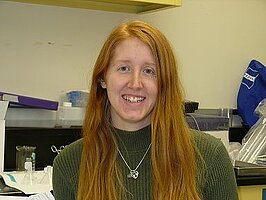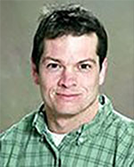Source tracking of Cryptosporidium in rural watersheds

Brianna (Schneck) Stenger is a graduate student (PhD) in the Environmental and Conservation Sciences (ECS) program and NDSU. She completed her B.S. in zoology (emphasis in fisheries, wildlife, ecology, and behavior) from NDSU in May of 2008. Brianna’s main research focuses on understanding Cryptosporidium adaptation and coevolution with host species and applying that knowledge to source tracking in rural watersheds.
Brianna.L.Schneck@ndsu.edu
Fellow: Brianna Schneck
Co-Advisors: Dr. John McEvoy, Department of Veterinary and Microbiological Sciences
Dr. Mark Clark, Department of Biological Sciences
Matching Support: North Dakota State University
Degree Progress: Ph.D. in Environmental and Conservation Sciences expected graduation 2013.
Source tracking of Cryptosporidium in rural watersheds
The Upper Midwest has among the highest incidences of human cryptosporidiosis in the U.S. (Hlavsa et al. 2005). There is therefore a critical need to determine Cryptosporidium sources and transmission dynamics in this region. A study, which I co-authored, has shown that most human cryptosporidiosis in the region is caused by C. parvum, a species associated with humans and cattle (Feltus et al. 2006). However, the traditional model, describing Cryptosporidium movement from livestock to humans via water, appears over simplistic in light of recent evidence of wildlife sources of contamination. To better understand the human health significance of Cryptosporidium in rural watersheds, we need to determine the source of the contamination. I will address this need by quantifying the impact of the wildlife and cattle sources in rural watersheds in the region. With the successful completion of this project, I expect to have clarified the public health significance of waterborne Cryptosporidium in rural watersheds. Outputs from this project will have regional, national, and international relevance and will be critical to the guidance of future policies on the control of Cryptosporidium transmission in water.
The present research is in continuation of the work proposed for the 2009 and 2010 NDWRRI program.
Project Objectives:
To determine the factors influencing the contributions of cattle and wildlife to Cryptosporidium in rivers. This is critical to understand the public health significance of Cryptosporidium in rural watersheds.
Progress:
Empirical evidence supports host adaptation and a limited host range for most Cryptosporidium species and genotypes. This knowledge has been used to track sources of water contamination and characterize human health risk; however, the factors affecting host range remain unclear. We are using small mammals (mainly rodent species) as a model to study the effect of factors such as host population density, diversity and behavior on the host range of Cryptosporidium genotypes.
Spring flooding results in the movement of Cryptosporidium from the fields of North Dakota, South Dakota and Minnesota to the Red River. Livestock contributed significantly to Cryptosporidium contamination in the Red River during major spring floods. Cattle were the primary source of surface water contamination. We can estimate the flow of oocysts during peak flooding in 2010 at 728,000 per second, based on our oocyst counts and a river flow of 560,000L per second. That is significant when it can take less than 100 oocysts to infect a host.
Small mammals are hosts to various genotypes of Cryptosporidium. We found Cryptosporidium species or genotypes in over 42% of our samples. We now have more than 600 samples and the prevalence is approximately 40%. We’ve identified at least 14 Cryptosporidium genotypes/species in 10 wildlife host species. We have found a novel genotype of Cryptosporidium in Eastern chipmunks and are planning to publish the findings once further molecular characterization and microscopic analysis is complete. Two species of Cryptosporidium, C. parvum and C. ubiquitum, are considered human pathogens, and were found in a number of wildlife samples.
Significance:
With the successful completion of the Objective, I expect to find that the prevalence of different wildlife and cattle associated Cryptosporidium species will be dependent on host abundance, prevalence of the parasite in the host population, and the number of oocysts being shed. As host numbers and parasite shedding rates fluctuate throughout the year, we expect to observe corresponding changes in the numbers and prevalence of Cryptosporidium in river samples. Results will be used to predict when different host species are likely to be significant sources of surface water contamination. For example, deer are known to herd more in the fall months and this may correlate with an increased environmental load of deer-associated Cryptosporidia and a corresponding increase in prevalence in the water. Understanding the dynamics of wildlife- and cattle-associated Cryptosporidia in a watershed is critical to any assessment of human health risks.
Publications:
Stenger, B.L., Pennil, C. C., Clark, M.E., Lanctot, V. , Giddings, C.W., and McEvoy, J.M. 2010 “Cryptosporidium transport in the Red River Valley during major spring floods” North Dakota State EPSCoR Conference, Grand Forks, ND, 2010.
Schneck, B.L., Pennil, C. C., Clark, M.E., Lanctot, V. , Giddings, C.W., and McEvoy, J.M. 2010 “Cryptosporidium transport in the Red River Valley during major spring floods” Summer COBRE poster presentation in Fargo, ND, 2010.
Schneck, B.L., Pennil, C.C., Lanctot, V.T., Giddings, C.W., Clark, M.E., and McEvoy, J.M. 2010 “Cryptosporidium genotypes in Midwestern mammals” Updated poster presented at the 7th Northern Plains Biological Sciences Symposium in Fargo, ND, 2010.
Schneck, B.L., Pennil, C.C., Lanctot, V.T., Giddings, C.W., Clark, M.E., and McEvoy, J.M. 2009 “Cryptosporidium genotypes in Midwestern mammals” Poster presented at III International Giardia and Cryptosporidium Conference, Orvieto, Italy, 2009.
Schneck, B.L., Moriarty, E.M., Giddings, C.W., and McEvoy, J.M. “The molecular characterization of Cryptosporidium mouse genotype I” Poster presented at III International Giardia and Cryptosporidium Conference, Orvieto, Italy, 2009.
Pennil, C. C., Clark, M.E., Schneck, B.L., Giddings, C.W., and McEvoy, J.M. 2009. “High prevalence of Cryptosporidium andersoni in surface water during a major spring flooding event” Poster presented at III International Giardia and Cryptosporidium Conference, Orvieto, Italy, 2009.

John McEvoy
AES Microbiological Sciences
Office: VanEs 132A
Telephone: 701-231-8530
Email: john.mcevoy@ndsu.edu

Mark Clark
Biological Sciences
Office: Stevens 119
Telephone: 701-231-8246
Email: m.e.clark@ndus.edu


